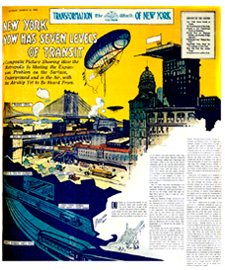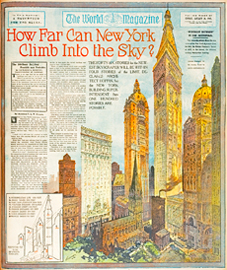The Skyscraper Museum is devoted to the study of high-rise building, past, present, and future. The Museum explores tall buildings as objects of design, products of technology, sites of construction, investments in real estate, and places of work and residence. This site will look better in a browser that supports web standards, but it is accessible to any browser or Internet device.

When Did New York Become Modern?


Left: "New York Now Has Seven Levels of Transit." New York World, March 14, 1909: cover of the "Transformation of New York" section. Illustrator, Louis Biedermann. Right: "How Far Can New York Climb into the Sky?" New York World, January 20, 1907, cover of the magazine section. Illustrator, Louis Biedermann.
New York at the turn of the twentieth century could be called unwittingly modern. If �modern� is a condition, rather than a style, then Manhattan was surely the most modern place on earth: its skyscrapers made it so. Indeed, in the 1910s, New York was the world�s only true skyscraper city, for Chicago restricted its high-rises to a maximum 260 feet. In 1909, the Metropolitan Life Tower rose to 700 feet, and in 1913, the Woolworth Building climbed to 792 feet and remained the world�s tallest building until 1929.
Still, New York�s towers of the �teens were conservative, disguised as a Venetian campanile or the neo-gothic "Cathedral of Commerce." A modern style in skyscraper architecture began to develop after 1922 when Hugh Ferriss and other architects recognized the power of the New York zoning law to shape the setback form and create an architecture of simple, sculptural mass.
The cartoons and architects' proposals here from the early 1900s through the 1920s address popular concerns about ascending heights, as well as crowding towers and new transportation technologies. The conditions of the modern city were the inspiration for the modernity of these proposals, even if the styles reflected in the architecture clung to the past.